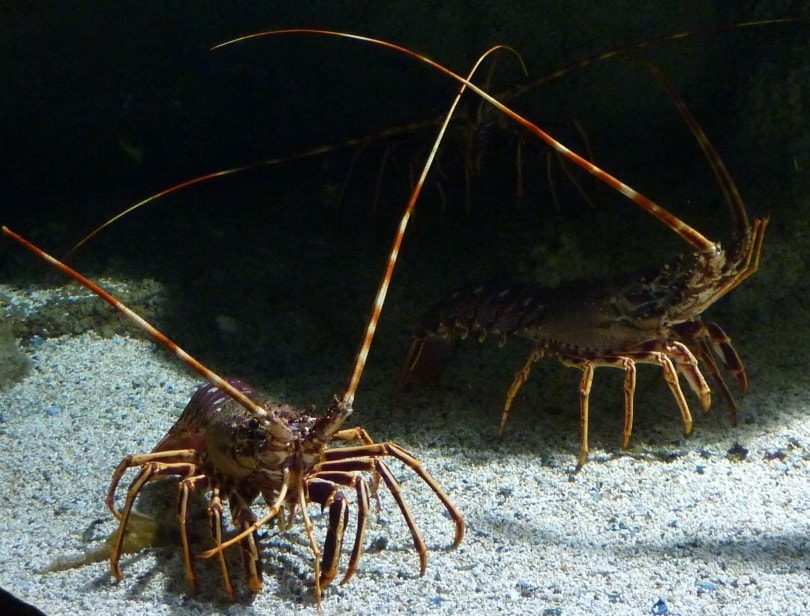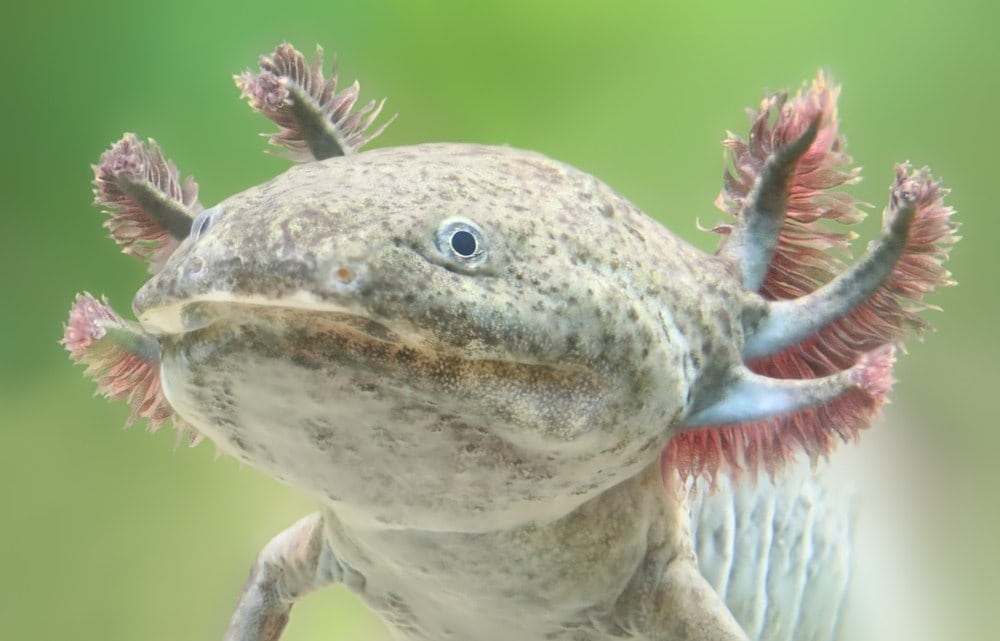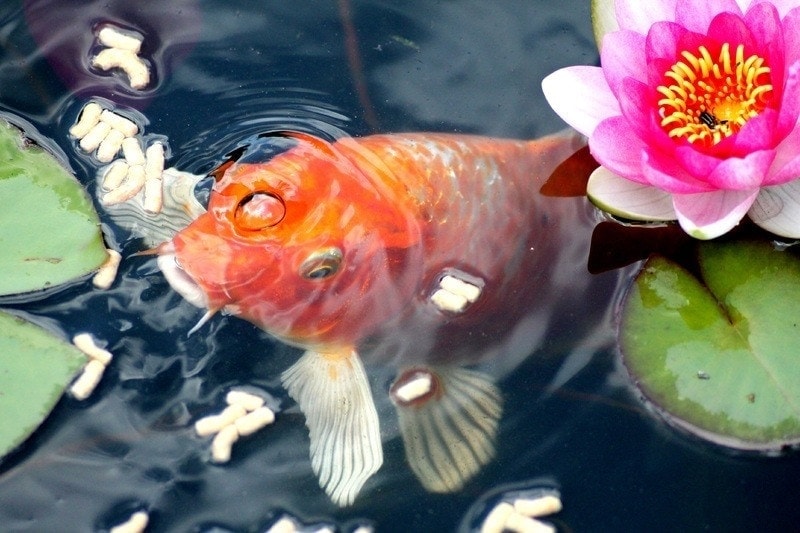Pictus Catfish: Care Guide, Types, Lifespan & Pictures

Updated on
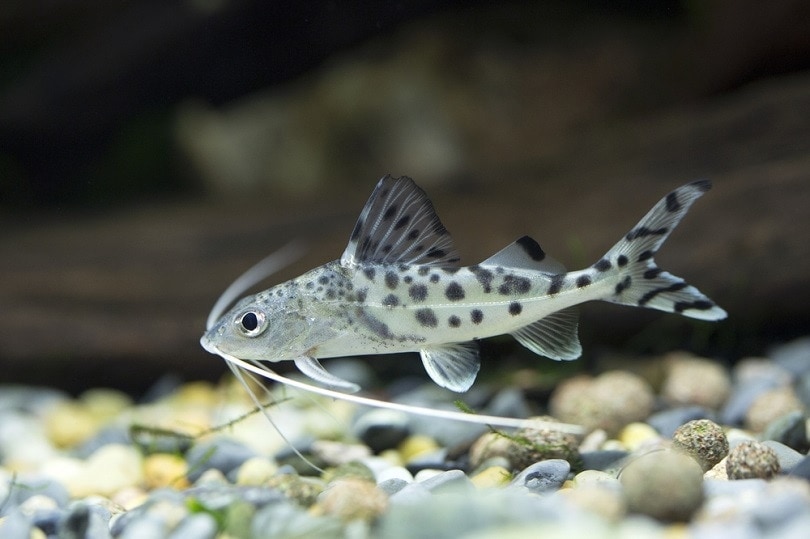
The Pictus catfish (Pimelodus pictus) is a scale-less bottom-dweller that is exceptionally popular in the aquarium hobby. The fish have attractive colors and interesting characteristics. They are active in an aquarium, and they are not ideal for novice fish keepers who struggle with keeping them free from disease and burns due to their scaleless bodies. They are a great challenge for intermediate aquarium keepers to maintain, and they make beautiful and interesting tank mates. They have great potential in the aquarium industry and are becoming increasingly popular.
Quick Facts About Pictus Catfish
| Species Name: | Pimelodus Pictus |
| Family: | Pimelodid |
| Care Level: | Moderate |
| Temperature: | 24°C to 28°C |
| Temperament: | Peaceful |
| Color Form: | Black & White |
| Lifespan: | 8 to 12 years |
| Size: | 5 inches |
| Diet: | Omnivore |
| Minimum Tank Size: | 40 gallons |
| Tank Set-Up: | Freshwater: caves & driftwood |
| Compatibility: | Community |
Pictus Fish Overview
The Pictus fish is commonly referred to as the Angel cat and is a member of the Pimelodidae family. They are one of the most popular scaleless fish in the aquarium trade and are great standouts in a community tank. Pictus only grow to a maximum size of 5 inches and require a large tank to keep up with their energetic behavior.
They require a minimum tank of 40 gallons as juveniles, and the only exception is that fully grown adults between 4 to 5 inches require a 75-gallon tank or more. These fish lack scales that most aquarium fish have. This makes them unsuitable for beginners who need a decent understanding and experience with scaleless fish.
Pictus catfish are susceptible to a range of diseases because of their scaleless bodies. A variety of medications are therefore unsuitable to treat them, and they will suffer from burns along their body as a result. Pictus catfish cannot be placed in methylene blue or malachite green. The medications are extremely hazardous to scaleless fish yet seem to be a common novice aquarist medication when they are treated for disease.
Interestingly, these fish were first described in the literature by Franz Steindachner who was an Austrian zoologist in the late 1870s. They are native to the warm waters of South America.
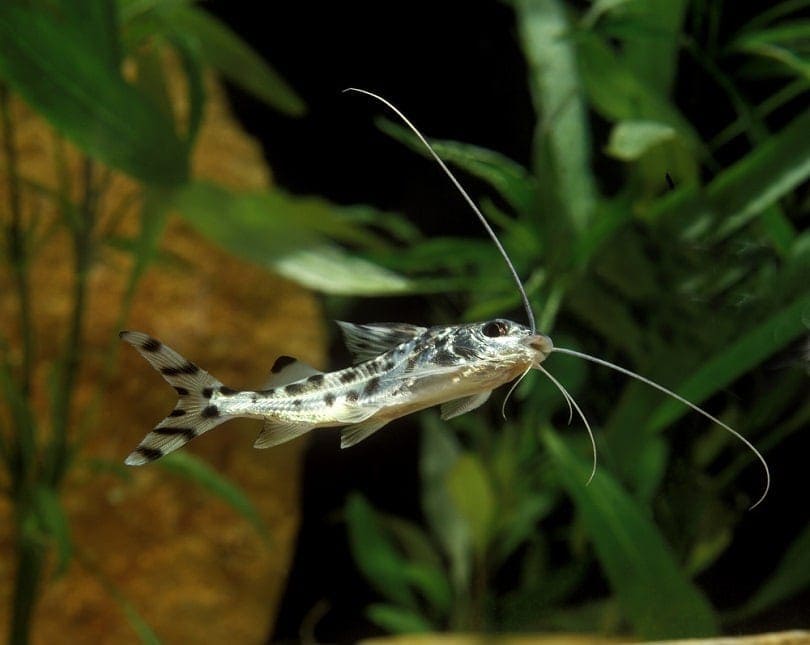
How Much Do Pictus Catfish Cost?
Pictus catfish can range from inexpensive to expensive depending on the coloration and size of your catfish. They are easily available in pet stores and range from $3 to $8. You can choose to order your pictus catfish online, and the price will range higher. This is because many pictus catfish bought online are from serious breeders who only breed quality stock.
They may sell the fish for a few dollars more than pet stores will charge. With the shipping total included, an average online price is $12–$15. The only downside to their inexpensive pricing is that it attracts new aquarium keepers who will not know how to appropriately care for a scaleless fish.
Typical Behavior & Temperament
Pictus catfish are primarily nocturnal and will be most active during the evenings or at night when you turn off the lights. They generally keep to themselves in the tank and will rarely bother other fast-swimming fish. They are active and energetic by nature and prefer to live in groups so they can form small shoals.
Although it is not mandatory to keep them in groups, it is an option for those who would rather have several in the same tank. Keeping them in groups helps them to become more outgoing, but you will have to provide a large tank (ideally over 150 gallons for 3 catfish). They are peaceful and timid fish, but they are still a predatory species.

Appearance & Varieties
Pictus catfish are unmistakable in an aquarium. They are silver in color with dark spots. The fins and barbels are transparent, and the sleek body grows between 4 to 5 inches in captivity. The barbels on the pictus catfish are commonly referred to as whiskers, but that is not the correct term. The barbels are used to help the fish locate food along the substrate both in captivity and in nature.
Since their natural habitat consists of a muddy floor, they need sensitive barbels to help them forage. The barbels typically reach their caudal fin. These fish have sharp spines that can inflict damage on other fish or a human’s hand. It is for this reason that you must avoid using a net or your hands to transfer or handle the pictus; a container or small bucket works better.
Their sharp spines have been known to tear up a net and cause the fish to become trapped. They are completely scaleless, which makes them extra sensitive to chemicals within the tank’s water. They do not have scales to protect them, which is why they should be treated cautiously with over-the-counter fish medication.
The pictus catfish displays a forked tail that is seen in many varieties of catfish. These fish are like Angelicus catfish, and the two are often confused. There are very few differences between the different genders. The females will be rounder by the belly, while the males will be slenderer with a flattened stomach.
A female can look unusually large if she is egg-bound. The species is also common to bloating after heavy meals, and the male’s stomachs will balloon out slightly. The gender is more easily identified when the pictus catfish has reached maturity.
How to Take Care of Pictus Catfish
Habitat, Tank Conditions & Setup
Tank/aquarium size: One pictus catfish should be in at least a 40-gallon tank. If you plan to add more, you should add on several gallons to ensure all the catfish have room to swim. As a rule of thumb, 150 gallons works for 3 full-grown catfish that are housed with other types of fish. It is best to get two of these fish to keep each other company. This will mean you should have a 100-gallon tank at a minimum. The larger the tank is, the more room you will have for filters, heaters, and aeration systems.
You should never keep a catfish in a spherical aquarium. Bowls and vases are poor housing systems that will result in a stressed catfish with a drastically shortened lifespan.
Water temperature & pH: These fish reside in natural tropical waters. Therefore, they need a heater. The temperature range should be from 24°C to 28°C. A good preset temperature for your heater is 26°C. This will ensure your catfish is kept healthy and free of any low temperature-induced diseases. The pH of the water should be between 7.0 to 7.5, and the water should be kept neutral.
Substrate: Since pictus catfish come from muddy origins, you should aim to use a sand substrate. Aquarium sand is our top choice for keeping a happy catfish. You want to avoid shark gravel as it will irritate the barbels of your catfish. Smooth pebbles can be used but do not provide the natural enrichment that sand does.
Plants: Live plants in your tank mirror the fish’s natural habitat. Plants will add shelter and block out excess light that may stress out your night-dwelling catfish. Smooth plastic plants can work, but silicone or silk plants are pricier. However, they will lessen the chance of a rough decoration scraping the pictus’ unprotected body.
Lighting: Because they are more active as night begins to fall, you should only keep them in dimly lit environments. If you have artificial lights, you should ideally use a timer to make sure the light goes off in the evening. Your catfish will be shy and seek shelter under tank decorations if the tank is exposed to bright light. They see best when their environment is dark or dimly lit.
Filtration: They require a good filter with moderate flow. Their foraging nature will make them pass waste more frequently. The filter will need to be able to filter five times the amount of water volume in a few minutes. Regular water renewals are required to keep the water parameters at ideal levels. Keep in mind that they are more susceptible to ammonia burns from their lack of scales.

Are Pictus Catfish Good Tank Mates?
Although pictus catfish are not aggressive or particularly territorial, considerations should be made when you are keeping other fish with your pictus catfish. They have sharp spines that will hurt fish like cichlids or acaras who swim slowly. For this reason, fast-shoaling fish are recommended. If you plan to keep other fish with them, ensure the tank is large enough to support the stocking rate. Below is a short list of our suitable and unsuitable tankmates for your pictus catfish.
- Tetras
- Danios
- Mollies
- Swordtails
- Platys
- Opaline Gourami
- Striped Raphael catfish
- Cichlids
- Oscars
- Acaras
- Plecos
- Bala sharks
- Angelfish
- Jack Dempsey’s
- The tankmates should not be aggressive or territorial. Not only will this stress both fish out, but the sharp spines of these fish will harm the tankmates.
- Other bottom-dwellers will become territorial towards your catfish and they will pick fights with one another.
- You should not overstock the tank. It will promote a spike in ammonia. The parameters need to be watched constantly as your catfish is sensitive to illness caused by poor water conditions from excess waste.
What to Feed Your Pictus Catfish
Pictus catfish will eat a variety of materials. They will gladly eat from the substrate and consume leftover debris or foods that have been fed to other fish. Although your catfish will eat what is leftover inside of the tank, they should ideally be fed a quality pellet, flake, or granule food.
The food should ideally sink for your catfish to be able to eat it. They will not usually go for floating foods and will not notice they are there. The size of the food should be designed according to their size and maturity. If you feed larger foods to a juvenile, you will risk overfeeding them.
You can also feed freeze-dried or live worms. Bloodworms, tubifex worms, and brine shrimp are good meal ideas. Algae should also make up a part of the main diet; it can be fed in the form of algae wafers or pellets.
Keeping Your Pictus Catfish Healthy
Keeping your pictus catfish is easy if you follow all the necessary care requirements. By keeping the tank’s water clean, you are eliminating spikes in ammonia, nitrites, and nitrates. Ensure the temperature is set to its most comfortable setting.
Feeding a quality diet full of vitamins and minerals will keep your pictus catfish healthy on the inside. By providing a large tank, you are providing a lot of room to correct any errors in your catfish’s care. Provide a setup like the one your catfish will experience in the wild. This will keep their stress levels down, which will boost their immune system. Ensuring your catfish are happy and thriving is the key to keeping them healthy.
Breeding
These fish are difficult to breed in captivity. This is another reason they are so expensive when ordered online from breeders. There are a few factors that inhabit their natural breeding methods. First, the tanks they are commonly kept in are too small.
Tanks over 155 gallons are still too small for your pictus catfish to reach their full maturity. Keeping a small shoal in a 250-gallon tank helps encourage them to breed. The breeding ritual is straightforward and consists of the female laying eggs that the male will fertilize. It is best to set up their breeding tank as close to their natural breeding conditions as possible.
Are Pictus Fish Suitable For Your Aquarium?
If you are looking for an interesting bottom and mid-dwelling fish with an appealing personality, the pictus catfish may be right for you. Your tank should be set up as naturally as possible and should be a freshwater, tropical tank. You should have compatible tank mates that have similar tank condition requirements. We hope this article has helped you learn the appropriate care that your pictus catfish requires.
Check out some of our top fish care guides:
Featured Image Credit: boban nz, Shutterstock




